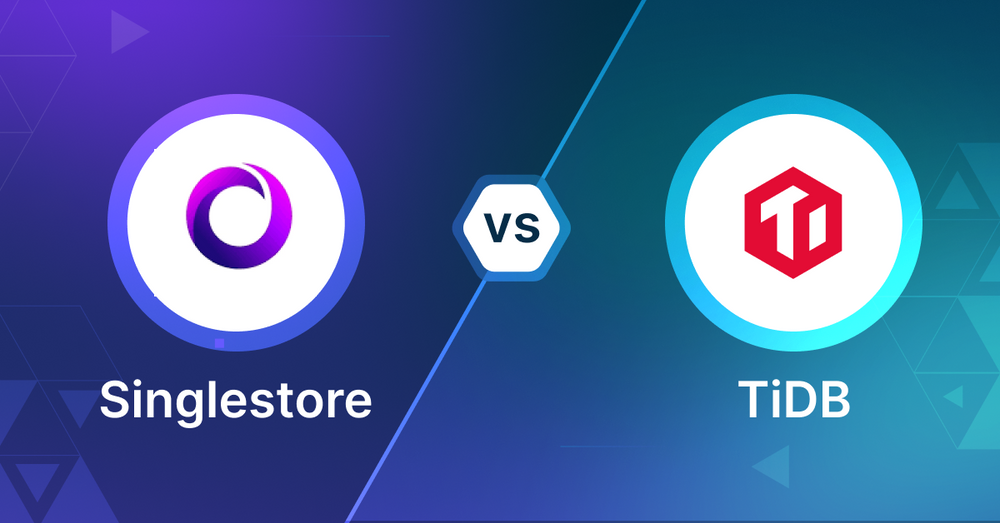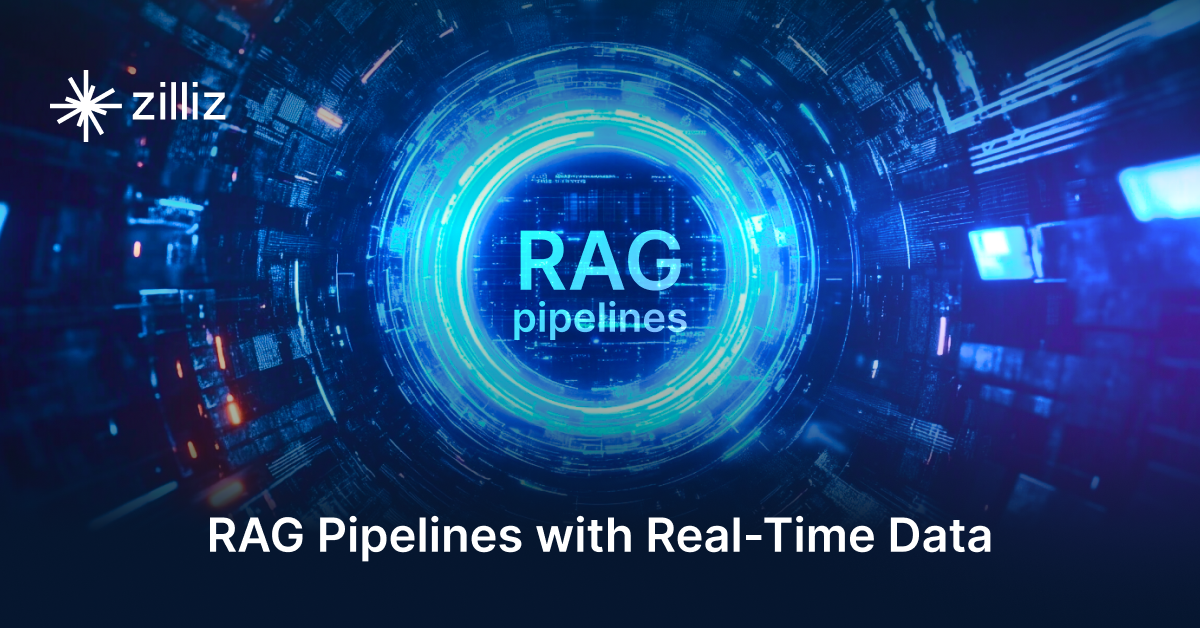SingleStore vs TiDB Choosing the Right Vector Database for Your AI Apps

What is a Vector Database?
Before we compare SingleStore and TiDB, let's first explore the concept of vector databases.
A vector database is specifically designed to store and query high-dimensional vectors, which are numerical representations of unstructured data. These vectors encode complex information, such as the semantic meaning of text, the visual features of images, or product attributes. By enabling efficient similarity searches, vector databases play a pivotal role in AI applications, allowing for more advanced data analysis and retrieval.
Common use cases for vector databases include e-commerce product recommendations, content discovery platforms, anomaly detection in cybersecurity, medical image analysis, and natural language processing (NLP) tasks. They also play a crucial role in Retrieval Augmented Generation (RAG), a technique that enhances the performance of large language models (LLMs) by providing external knowledge to reduce issues like AI hallucinations.
There are many types of vector databases available in the market, including:
- Purpose-built vector databases such as Milvus, Zilliz Cloud (fully managed Milvus)
- Vector search libraries such as Faiss and Annoy.
- Lightweight vector databases such as Chroma and Milvus Lite.
- Traditional databases with vector search add-ons capable of performing small-scale vector searches.
SingleStore is a distributed, relational, SQL database management system and Rockset is a search and analytics database with vector search capabilities as an add-on. Both have vector search capabilities as an add-on. This post compares their vector search capabilities.
SingleStore: Overview and Core Technology
SingleStore has made vector search possible by putting it in the database itself, so you don’t need separate vector databases in your tech stack. Vectors can be stored in regular database tables and searched with standard SQL queries. For example, you can search similar product images while filtering by price range or explore document embeddings while limiting results to specific departments. The system supports both semantic search using FLAT, IVF_FLAT, IVF_PQ, IVF_PQFS, HNSW_FLAT, and HNSW_PQ for vector index and dot product and Euclidean distance for similarity matching. This is super useful for applications like recommendation systems, image recognition and AI chatbots where similarity matching is fast.
At its core SingleStore is built for performance and scale. The database distributes the data across multiple nodes so you can handle large scale vector data operations. As your data grows you can just add more nodes and you’re good to go. The query processor can combine vector search with SQL operations so you don’t need to make multiple separate queries. Unlike vector only databases SingleStore gives you these capabilities as part of a full database so you can build AI features without managing multiple systems or dealing with complex data transfers.
For vector indexing SingleStore has two options. The first is exact k-nearest neighbors (kNN) search which finds the exact set of k nearest neighbors for a query vector. But for very large datasets or high concurrency SingleStore also supports Approximate Nearest Neighbor (ANN) search using vector indexing. ANN search can find k near neighbors much faster than exact kNN search sometimes by orders of magnitude. There’s a trade off between speed and accuracy - ANN is faster but may not return the exact set of k nearest neighbors. For applications with billions of vectors that need interactive response times and don’t need absolute precision ANN search is the way to go.
The technical implementation of vector indices in SingleStore has specific requirements. These indices can only be created on columnstore tables and must be created on a single column that stores the vector data. The system currently supports Vector Type(dimensions[, F32]) format, F32 is the only supported element type. This structured approach makes SingleStore great for applications like semantic search using vectors from large language models, retrieval-augmented generation (RAG) for focused text generation and image matching based on vector embeddings. By combining these with traditional database features SingleStore allows developers to build complex AI applications using SQL syntax while maintaining performance and scale.
What is TiDB? An Overview
TiDB, developed by PingCAP, is an open-source, distributed SQL database that offers hybrid transactional and analytical processing (HTAP) capabilities. It is MySQL-compatible, making it easy to adopt for teams already familiar with the MySQL ecosystem. TiDB's distributed SQL architecture provides horizontal scalability like NoSQL databases while retaining the relational model of SQL databases, making it highly flexible for handling both transactional and analytical workloads.
One of TiDB's core strengths is its HTAP architecture, which allows it to process transactional (OLTP) and analytical (OLAP) workloads in a single database, reducing the need for separate systems. Additionally, TiDB's MySQL compatibility makes it easy to integrate into existing environments that rely on MySQL without significant changes to the application code. The database also features auto-sharding, automatically distributing data across nodes to improve read and write performance while maintaining strong consistency.
TiDB supports vector search through integration with external libraries and plugins, enabling efficient management and querying of vectorized data. This feature, combined with TiDB's HTAP architecture, makes it a versatile option for businesses needing vector search capabilities alongside transactional and analytical workloads. The distributed architecture of TiDB allows it to handle large-scale vector queries once the necessary configurations are in place.
While including vector search functionalities in TiDB requires additional configuration, the system's SQL compatibility allows developers to combine vector search with traditional relational queries. This flexibility makes TiDB suitable for complex applications that require both vector search and relational database capabilities, offering a comprehensive solution for diverse data management needs.
Key Differences
Search Methodology
SingleStore has in-database vector search with both exact k-nearest neighbors (kNN) and Approximate Nearest Neighbor (ANN) search. You can tune precision and speed based on your application needs. With built-in support for vector indexing methods like FLAT, IVF_FLAT and HNSW, SingleStore can do high performance similarity matching within the database itself, with no need for separate vector specific systems.
TiDB on the other hand integrates vector search through external libraries and plugins. While this gives it more flexibility, the reliance on external components can add complexity and performance variability. TiDB’s strength is in combining vector queries with its hybrid transactional and analytical processing (HTAP) architecture but that requires extra configuration.
Data Handling
SingleStore can store vector data in columnstore tables and do SQL operations along with vector queries. This makes it easy for applications like semantic search or AI powered recommendations. But it’s limited to Vector Type(dimensions[, F32]) format which might not be flexible for some use cases.
TiDB can handle various workloads, structured, semi-structured and unstructured data. Its MySQL compatibility makes it easy to adopt for teams already in that ecosystem. For vector data TiDB uses external tools, gives flexibility but at the cost of extra setup and potential overhead.
Scalability and Performance
SingleStore distributes vector and relational data across nodes, easy scalability. As data grows, adding nodes gives you consistent performance without changing architecture. Its built-in ANN indexing optimizes query speed for large datasets, for applications with billions of vectors.
TiDB also has horizontal scalability through its distributed SQL architecture, with auto sharding and load balancing. Its scalability for relational workloads is proven, but performance of vector queries depends on the external integration chosen which might not scale as smoothly.
Flexibility and Customization
SingleStore is optimized for SQL based vector search, so you can use familiar syntax to build your application. But its structured approach to vector indexing and storage might limit flexibility compared to systems built only for vectors.
TiDB has more customization since it uses external libraries for vector search. You can configure to your needs, so it’s a good choice for scenarios that require more customization beyond out of the box.
Integration and Ecosystem
SingleStore integrates well with AI and ML pipelines by allowing SQL operations on vector embeddings from models like OpenAI’s or Hugging Face’s. This reduces data transfer overhead and makes application development seamless.
TiDB has strong MySQL compatibility so it’s easy to integrate with existing MySQL tools and ecosystem. But its vector search depends on external libraries which require extra effort to integrate into end-to-end workflows.
Ease of Use
SingleStore simplifies development with one system for both vector and relational operations. Its documentation and support for common indexing methods makes it easy for developers who want all in one solution.
TiDB while developer friendly for relational tasks, might have a steeper learning curve for vector search, since you need to configure extra and external tools.
Cost
SingleStore puts vector and relational data management into one system, might reduce cost of maintaining separate databases. But licensing and scaling costs should be evaluated based on workload.
TiDB is open-source and has a cost advantage for basic setup. But adding vector search via external libraries might incur extra operational and maintenance costs.
Security
SingleStore has encryption, role based access control and secure connections as part of its enterprise offering, so it’s good for sensitive applications.
TiDB has security features too, encryption and access control. But external plugins for vector search requires extra attention for compliance and security.
When to Choose SingleStore
SingleStore is great for applications that need a single system to handle both vector search and relational queries at scale. With built-in exact kNN and ANN indexing and the ability to combine vector search with SQL, it’s perfect for AI powered applications like semantic search, recommendation systems and image recognition. If you need fast similarity matching, seamless node scaling and less complexity managing separate systems, SingleStore’s integrated approach gives you high performance and ease of use for big data.
When to Choose TiDB
TiDB is great for scenarios where hybrid transactional and analytical processing (HTAP) is required, especially within the MySQL ecosystem. It’s perfect for applications that need transactional consistency with analytical workloads, like real-time data analysis or operational intelligence. If your use case involves full-text search or requires custom config for vector search as an add-on feature, TiDB allows you to integrate with external libraries while leveraging its distributed SQL capabilities and auto-sharding for scalability.
Conclusion
SingleStore and TiDB are both great, SingleStore is good at unified vector and relational query at scale and TiDB is good at HTAP and customization. Your choice depends on your use case: choose SingleStore if you need an all-in-one solution for high performance vector search or choose TiDB if your priorities are HTAP, MySQL compatibility and custom integrations. Match the technology to your data types, scalability requirements and performance needs and you’ll get the best results.
Read this to get an overview of SingleStore and TiDB but to evaluate these you need to evaluate based on your use case. One tool that can help with that is VectorDBBench, an open-source benchmarking tool for vector database comparison. In the end, thorough benchmarking with your own datasets and query patterns will be key to making a decision between these two powerful but different approaches to vector search in distributed database systems.
Using Open-source VectorDBBench to Evaluate and Compare Vector Databases on Your Own
VectorDBBench is an open-source benchmarking tool for users who need high-performance data storage and retrieval systems, especially vector databases. This tool allows users to test and compare different vector database systems like Milvus and Zilliz Cloud (the managed Milvus) using their own datasets and find the one that fits their use cases. With VectorDBBench, users can make decisions based on actual vector database performance rather than marketing claims or hearsay.
VectorDBBench is written in Python and licensed under the MIT open-source license, meaning anyone can freely use, modify, and distribute it. The tool is actively maintained by a community of developers committed to improving its features and performance.
Download VectorDBBench from its GitHub repository to reproduce our benchmark results or obtain performance results on your own datasets.
Take a quick look at the performance of mainstream vector databases on the VectorDBBench Leaderboard.
Read the following blogs to learn more about vector database evaluation.
Further Resources about VectorDB, GenAI, and ML
- What is a Vector Database?
- SingleStore: Overview and Core Technology
- What is TiDB? An Overview
- Key Differences
- Using Open-source VectorDBBench to Evaluate and Compare Vector Databases on Your Own
- Further Resources about VectorDB, GenAI, and ML
Content
Start Free, Scale Easily
Try the fully-managed vector database built for your GenAI applications.
Try Zilliz Cloud for FreeKeep Reading

Building RAG Pipelines for Real-Time Data with Cloudera and Milvus
explore how Cloudera can be integrated with Milvus to effectively implement some of the key functionalities of RAG pipelines.

Empowering Innovation: Highlights from the Women in AI RAG Hackathon
Over the course of the day, teams built working RAG-powered applications using the Milvus vector database—many of them solving real-world problems in healthcare, legal access, sustainability, and more—all within just a few hours.

The AI Revolution in Marketing: How Vector Databases Are Unlocking True Personalization
Explore how vector databases and AI are transforming marketing platforms, enabling real-time personalization and predictive analytics while balancing automation with creativity.
The Definitive Guide to Choosing a Vector Database
Overwhelmed by all the options? Learn key features to look for & how to evaluate with your own data. Choose with confidence.